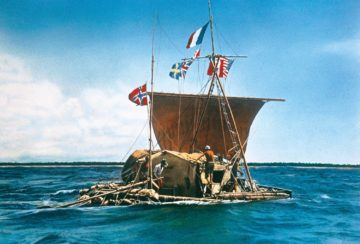Nathan Beacom at The New Atlantis:
 As he later told the story in Kon-Tiki: Across the Pacific by Raft, he was brushed off by many in the scientific establishment — and so went to extraordinary lengths to prove the theory’s plausibility, reconstructing the ancient journey by sailing across the sea on a wooden raft in 1947. This spectacular feat captured the imagination of the world, and researchers, skeptical as they might have been, have ever since debated what really had happened in prehistoric times between South America and Polynesia (the group of Pacific islands stretching from New Zealand to Hawaii). Most scientists never accepted the amateur anthropology in which Heyerdahl couched his theory, but the mystery of an ancient trans-Pacific journey was a live one. All sorts of evidence would be marshalled, sometimes seeming to affirm Heyerdahl in part, sometimes seeming to show him entirely wrong.
As he later told the story in Kon-Tiki: Across the Pacific by Raft, he was brushed off by many in the scientific establishment — and so went to extraordinary lengths to prove the theory’s plausibility, reconstructing the ancient journey by sailing across the sea on a wooden raft in 1947. This spectacular feat captured the imagination of the world, and researchers, skeptical as they might have been, have ever since debated what really had happened in prehistoric times between South America and Polynesia (the group of Pacific islands stretching from New Zealand to Hawaii). Most scientists never accepted the amateur anthropology in which Heyerdahl couched his theory, but the mystery of an ancient trans-Pacific journey was a live one. All sorts of evidence would be marshalled, sometimes seeming to affirm Heyerdahl in part, sometimes seeming to show him entirely wrong.
The question Heyerdahl had thrust into the spotlight with some forty feet of balsa wood and a handful of sunburnt Scandinavians — namely, whether an ancient journey really had been made between South America and Polynesia — would take seven decades of anthropology, botany, linguistics, archaeology, genetic analysis, and computer science to answer.
more here.
